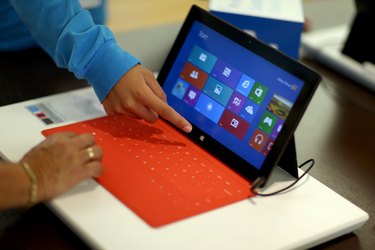
Windows uses the process identifiers, displayed under the optional PID column in the Task Manager, to tell programs and processes apart. The operating system assigns every process an identification number when it's started as a way to tell processes apart without relying on process names. If a program has a high-numbered PID, it doesn't necessarily mean there are a lot of programs running; to avoid errors, the operating system will not re-assign a used PID immediately.
Finding the PID
Video of the Day
You can find all active program PIDs on the "Processes," "Details" and "Services" tabs in the Task Manager as long as PID display is enabled. PIDs are enabled on the "Details" and "Services" tabs and disabled on the "Processes" tab by default in Windows 8. To enable the PID in the "Processes" tab, right click on the header and select "PID" from the columns list. The process's unique PID is displayed in the PID column for each program. According to the Microsoft Developer Network, the PID was removed from the default display on the "Processes" tab because Microsoft's research found the value irrelevant for most users.
Video of the Day
Identifying Identically Named Processes
The PID keeps Windows from mixing up programs; it is useful when troubleshooting programs that share the same name or run multiple instances at once. If you have two different programs running that use processes called "My Process," Windows will assign different PIDs to each one, which you can use to tell the programs apart in the Task Manager. "My Process #1" and "My Process #2" could do entirely different things, but the computer can't tell them apart without a PID. Additionally, Windows can tell apart separate instances of an instant messaging program that can be run multiple times at once for simultaneous multi-user login with PIDs.
Tracking Problematic Processes
The PID can help in the troubleshooting process for programs that split up content and instructions across multiple processes. A program like Google Chrome may use many separate processes that are all named "Google Chrome." Each browser tab gets its own process so that if it runs into a problem and crashes it doesn't take down the other tabs with it. You can keep track of a hanging or locked-up tab with the PID or use the PID to mark tabs you want to keep open when closing hanging or frozen tabs in the Task Manager.
Troubleshooting Process Conflicts
PIDs are useful in troubleshooting processes that are conflicting over network ports. The Netstat tool uses PIDs to identify which processes are using which network ports. Netstat's diagnostics will show if two processes are trying to use the same ports, and conflicts can be resolved by closing one of the competing programs. PID values are an easier way to enter commands for processes and display useful information. For example, "526" takes up less space on screen and is easier to type than "My Awesomely Named Process (64-bit)."
- Computer Hope: PID
- Linfo.org: PID Definition
- Microsoft Support: The Process Object in Performance Monitor Can Display Process IDs (PIDs)
- TechRepublic: Deep Troubleshooting With the Windows 8 Task Manager Processes Tab
- Microsoft Developer Network Blogs: Building Windows 8: The Windows 8 Task Manager
- CNET: How to Use Windows 8 Task Manager
- Microsoft Support: The Netstat Command Can Now Display Process IDs that Correspond to Active TCP or UDB Connections in Windows 2000